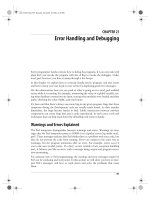Chapter 4. Exception Handling pdf
Bạn đang xem bản rút gọn của tài liệu. Xem và tải ngay bản đầy đủ của tài liệu tại đây (219.86 KB, 10 trang )
Chapter 4. Exception Handling
Hoàng Hữu Việt
IT Faculty, Vinh University
A reference of MSDN Library for
Visual Studio 2005
Slide 2
Chapter 4. Exception Handling
Contents
Introduction
Exception Class
Try statement
Example
Slide 3
Chapter 4. Exception Handling
Introduction
An exception is any error condition or
unexpected behavior encountered by an
executing program.
Exceptions can be raised because of a fault in
your code or in code you call (such as a
shared library), unavailable operating system
resources, unexpected conditions the
common language runtime encounters (such
as code that cannot be verified), and so on.
Slide 4
Chapter 4. Exception Handling
Introduction
In the .NET Framework, an exception is an
object that inherits from the Exception Class
class. An exception is thrown from an area of
code where a problem has occurred. The
exception is passed up the stack until the
application handles it or the program
terminates.
Slide 5
Chapter 4. Exception Handling
Exception Class
The Exception class is the base class from
which exceptions inherit. Most exception
objects are instances of some derived class of
Exception, but you can throw any object
that derives from the Object class as an
exception.
Slide 6
Chapter 4. Exception Handling
Exception Class
Common Properties
Message: Provides details about the cause of an
exception.
StackTrace: Contains a stack trace that can be
used to determine where an error occurred. The
stack trace includes the source file name and
program line number if debugging information is
available.
Slide 7
Chapter 4. Exception Handling
Try statement
A common usage of catch and finally
together is to obtain and use resources in a
try block, deal with exceptional
circumstances in a catch block, and release
the resources in the finally block
Slide 8
Chapter 4. Exception Handling
try statement
try catch finally Statement
try
{
1. Include codes in which exceptions might
occur.
}
catch (Exception )
{
2. Represent types of exceptions the catch can
handle.
}
finally
{
3.(Optional) codes present here will always
execute.
}
Slide 9
Chapter 4. Exception Handling
Example
Example: Divide by zero
Error Message
Error Message
Slide 10
Chapter 4. Exception Handling
Example
Code pattern
private void btnDivide_Click(object sender,
EventArgs e)
{
textBox3.Clear();
try
{
int a = Convert.ToInt32(textBox1.Text);
int b = Convert.ToInt32(textBox2.Text);
int c = a / b;
textBox3.Text = c.ToString();
}
catch(Exception ex)
{
MessageBox.Show(ex.Message);
}
}









